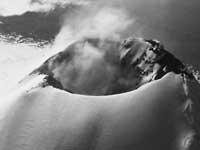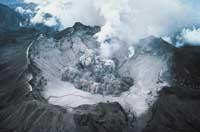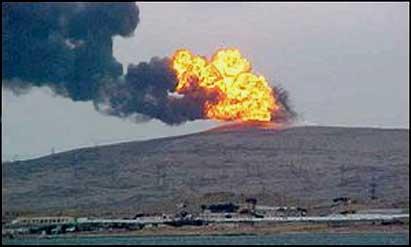Earthquakes to investigate volcanoes
2002/01/28 Kortabarria Olabarria, Beñardo - Elhuyar Zientzia
Eight European states, Austria, Spain, France, Greece, England, Ireland, Italy and Portugal, start working together to investigate the risks of volcanic eruptions. The objectives of the project are to predict 2-3 days before the eruption, predict how the eruption will be, raise awareness of the potential risk and foresee the consequences for people living in the volcano environment. At present it is possible to detect eruptions 2-3 months in advance, but without greater precision.
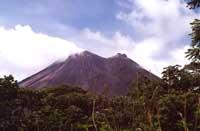
The project officially began on the first day of 2002. First, five volcanoes will be controlled: Teide, Vesuvius, the volcano of the Greek island of Santorini, the volcano of the island of Reunion, next to Madagascar, and those of Azores.
All these volcanoes will be monitored, that is, numerous stations of measurement of the underground seismic activity will be installed. In fact, the main source for data on volcanic eruptions are seismic movements, since the lava that leaves the craters is, in short, the result of the earthquake that occurs in the subsoil.
Seismic activity in volcanoes can begin months or years before any movement that occurs abroad, for example before steam, emissions or gases begin to be released.
There is often no movement before the volcano's influence is evident, but a few hours before eruptions occur and during the eruption, seismic activity is impressive and in a few hours hundreds of earthquakes can occur.
If we look at the statistics, we must say that the seismic activity in the volcanoes has risen very rarely more than 6 degrees on the Richter scale, which means that they can feel, but in reality they can hardly cause damage.
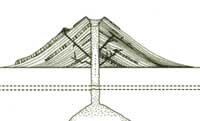
Knowing the volcanoes well is very important. And it is that the lands that surround the volcanoes are so fertile that many people are concentrated in them. The Vesubio volcano can be one of the clearest examples. In the city of Naples, today, more than 3 million people live, so in case of eruptions a great disaster can occur.
The human being has been conscious for a long time. In ancient Rome Seneca discovered the origin of the basic structure of volcanoes.
He noted that volcanoes are the place where the melted material is extracted. Until then, the Platonic theory, with rivers of fire underground, and that of Aristotle, with compressed air burning sulfur in the underground, were in force.
In the year 79 there was a great eruption of the volcano Vesubio. The eruption destroyed Pompeii and Herculaneum. Old Pliny died watching the eruption. His nephew, the young Pliny, wrote what his uncle said about the seismic activity of the volcanoes. Therefore, they were already aware of the influence of earthquakes on volcanoes.
Since that time, much progress has been made. Seismographs have become common in the investigation of volcanoes. And from now on it seems that investigating the movements of the earth will be able to know much more about the volcanoes.
Giant eruptions
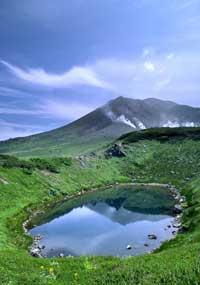
Eruptions are relatively frequent natural phenomena. Most are small, but they are also terrible that have caused many damage. Perhaps the most prominent in history are:
- a.C. 1500: 1500: 1500 The volcano of the island of Santorini exploded. According to legend, the mythical island of Atlantida disappeared.
- 79: 79 Vesubio volcano. It is the most mythical volcano in Europe. That year the cities of Pompeii and Herculaneum were destroyed. In 1999 he resumed his eruption and provoked a great terror.
- 1815: Tambora Volcano in Indonesia. It burst sharply into the eruption. 50,000 dead. It has been the most deadly eruption in history.
- 1883: The Perbuatan volcano exploded on the island of Krakato. Around the island half went to the bottom of the sea and giant waves emerged. There were 36,000 people killed.
- 1902: 1902: Mont Pelé, on the island of Martinique. It caused 36,000 dead and destroyed the pier of Saint Pierre.
- 1991: 1991: 1991 Pinatubo Volcano in the Philippines. It was one of the most violent eruptions of the last century, causing 1,000 dead and 1,000,000 people had to leave their homes. Since the Perbuatan volcano erupted in 1883, it caused the greatest atmospheric disturbance.
Teide lives alive
In the Spanish state there is only one volcano, the well-known Teide. The volcano of the Canaries is not long dead, it will wake up sooner or later. It does not seem to be tomorrow, nor tomorrow, but there is no doubt that it will erupt again. The activity under Teide has not remained. In this sense, it can be said calmly that it is still an active volcano. Teide is not the only case in the world; according to experts, the situation of 600 other volcanoes is similar.
How do volcanoes work?
Volcanoes are phenomena of nature, cracks or holes in the terrestrial surface. In many languages, the word "sumendi" means mountain that emits smoke or, as in the case of Basque, a mountain that throws fire. In most languages, however, words from Latin Vulcanus are used. Vulcano was the god of fire in Roman mythology.
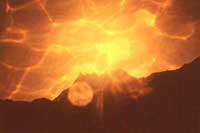
From the aforementioned cracks or holes magmas or underground rocks are extracted. The magma is the material resulting from the fusion of rocks by high underground temperatures. For its expulsion it is driven by underground gases. When they find the exit form the lava rivers. Also, when the temperature changes, the lava cools down and hardens. As a consequence, the cono-volcanic is slowly formed.
Therefore, when the gases do not find a way out, they cause a seismic movement, but not an eruption. That is, all eruptions are a consequence of the earthquake, but not all earthquakes are capable of causing eruptions.
The eruptions are classified by agents. Thus, there is talk of magmatic eruptions when the eruption is a consequence of magma or magmatic gas, while when magma or magmatic gas heats underground water and this causes the eruption, the eruption is freatic. In these cases, sometimes magma products appear mixed with steam and these eruptions are freatomagmatic.
Other ways to classify the eruptions are, for example, if it is like an eruption that has been famous throughout history, or if it occurs in a certain way. Thus are the Hawaiian eruptions, due to the way in which the volcanoes of the area start the eruption, the strombolians, vulcanians or peleans, due to the characteristics that are collected in the eruptions of these volcanoes, the Plinians —when the characteristics that Pliny mentioned when describing the eruption of the Vesuvius— appear, the Icelanders are released in the eruptions due to the great arrival. The diversity of forms of energy release makes it very difficult for experts to measure eruptions and researchers in volcanic research have not yet given a concrete solution to this problem.
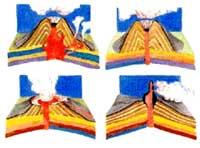
However, to measure the size of the eruptions, different systems are used. The most widespread method is that of Walker. He proposed it in 1980 and says that to correctly determine the origin and size of the eruptions, five variables must be taken into account:
- Size of the mass, mass of all the material thrown by the volcano.
- Intensity, the time that the volcano has taken to launch the whole mass.
- Dispersion capacity, surface covered by the eruption. The height of the eruption is also considered.
- Violence, kinetic energy generated in the explosion.
- Capacity of destruction, measure of the disaster caused by the eruption, especially with regard to buildings, sowing or sowing land and vegetation.
Volcanoes of different shapes
Although there are several ways to classify volcanoes, they are usually classified by their shape. Due to its shape, there are three types of volcanoes:
Cone ash ashes
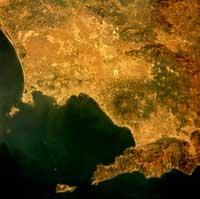
By stacking the ash that comes out in the eruptions, cones are often formed. In these cases, hot materials that harden in the air are usually predominant and localize very close to the center of the eruption. The walls of the cones cannot have large slopes, between 30º and 40º approximately. They have a circular base, conical shape and often more than 300 meters high. Many of the South Americans are of this type, but perhaps the most remarkable, for its appearance, can be the Xitle volcano.
Hidden, Hidden Object
Those with more diameter than height are called this way. They are formed by soft lava currents, so they are usually of little height and little slope. Its topography is smooth and its summit is quite flat. Most of the volcanoes of Hawaii and those of the Galapagos Islands are like this.
Stratum Estrato
They are volcanoes formed by fractionable materials and soft furnaces. This means that they were formed as a result of sudden explosions and improvised breaks. This is the case of the Mexican volcano Popopocatépetl.
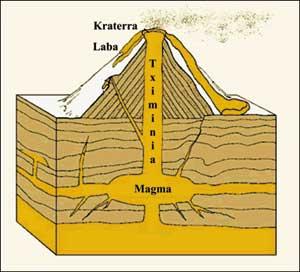
Published in section D2 of Deia.

Gai honi buruzko eduki gehiago
Elhuyarrek garatutako teknologia




